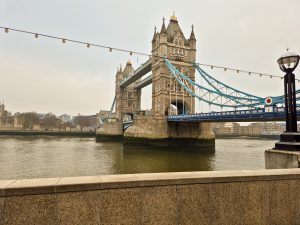
Bridge View
It’s a fine view even when it’s a bit foggy
Back in Heather and I visited Tower Bridge. As I briefly mentioned, it happens to be Heather’s favourite bridge, so I thought she deserved to see bit more of it as a little birthday treat. Which is why we found ourselves on a cold Saturday morning, standing outside the engine rooms, ready for a guided, behind the scenes tour.

Engine
One of the wonderful steam engines
Starting at the engine rooms is actually a bit unusual—the guided tour normally takes the standard route from the north tower, across the walkways, and then the engines (with behind the scenes bit thrown in), but because of lift work for some reason they decided to do it sort of in reverse. That at least changed things up a bit from the last visit There’s a standard guided tour that doesn’t have the behind the scenes part. To be honest I don’t think that’s worth the money. Our guide was friendly and knowledgable, but didn’t impart anything you couldn’t get from the info boards. There was however a sense of deja vu so close to the last visit, although it gave the chance to note things a bit closer having read the guidebooks since then.
Doing things in the wrong order also means we were quite quickly on the exciting part of the tour—one suspects there’s a bit more of a build up of anticipation normally. Having circled the steam engines and squeezed through the shop we climbed the steps to the bridge road deck. There chains and barriers were removed and we found ourselves in the (now disused) south-east control room, joined by an enthusiastic member of the engineering team which look after (and “drive”) the bridge.

Control Cabin
The original control cabin of the bridge
The control room itself is reminiscent of a railway signal box. Windows give a good view of the river, and there are lots of levers to control various interlocks, bolts and mechanisms. A wooden board with an array of brass pressure gauges gives an overview of available power and action, while above those sits a wooden indicator panel to show the state of the bolts and blocks which hold and support the bridge.
Having posed for obligatory photographs we were led out the cabin and down into the bowls of the bridge. Below lies the machine room, which actually drives the opening of the great bascules. An original version of the engines sits in one corner, its paintwork a bit less gleaming than the example which has these days been transported to sit beside the shop in the engine rooms. It’s more modern cousins are even less gleaming, great bulks of machinery without the grace the Victorians may have imparted to their designs, but with more efficiency and suited to a modern age of electricity rather than steam—they are still not without their reliability quirks though!

Down
The way down, complete with orgiinal accumulator
From there it was down even further. A vertiginous spiral staircase (one of our little group of about ten or so suffered from acrophobia—I was impressed with her making it down), gives way to a platform within what was once an accumulator chamber. The massive steel accumulator itself still sits in place, defying logic almost in how it came to be there. Further stairs head even deeper into the bridge foundations beneath the tower. At the bottom an arch gives entrance to the star of the show, the truly cavernous bascule chamber where the great hulk of the bridge swings down, counterweighting the lifting road.

Swing Route
Note the access walkway for maintenance
It really is a spectacular space, it’s stepped rear wall curving upwards and giving the impression of a vast auditorium. There is noise to fill it too; the rumbling of the cars passing above and the sound of boats passing on the river—the waterline is well above the floor we were standing on. The pawls on which the bridge rests when closed looked tiny and inadequate, as do the railway sleeper like stops which mark the full extent of the swing. There would, we were assured, just be enough space to stand out the way behind those stops, safe from the descending tons of steel, but I don’t think I’d like to put that to the test.
And so having stood and wondered at the space, and listened, and wandered, we were led back up the many stairs and out into the damp and foggy London air. From there, other than the thrill of going the “wrong way” up the south tower which normally forms the exit, there was a bit of a sense of anticlimax. Even the views from the walkways weren’t being their thrilling best, the fog making Canary Wharf a dull outline, the Shard vanishing into cloud.
The guided finished on the glass walkway as high above the bascule chamber as we would get. We didn’t hang around much, we’d been there and done that. But the memory of those spaces (there is, of course, a matching one beneath the north tower) will linger long.

The Crossing

Bridge View

Boiler

Steam Pipes

Coal Lift

Engine

Engine Room

Accumulators

Engine

Foggy Thames

Dials And Indicators

Levers

Driving Handle

Signals Again

Try To Resist Pulling

Driving

Steam Raising

Modern Equipment

Cable

Hardware

Powerful

Victorian Lifting

More Modern Equipment

Down

Accumulator Shaft

Beneath The Bridge

Bridge End

Engineering

Stoppers

Support

Quadrant

Swing Route

Steps

Top Of The Chamber

Conecert Hall

Ridge

Control Cabin

High

Flying

Misty

Short Shard

Mirrored Ceiling

Comments and Pings